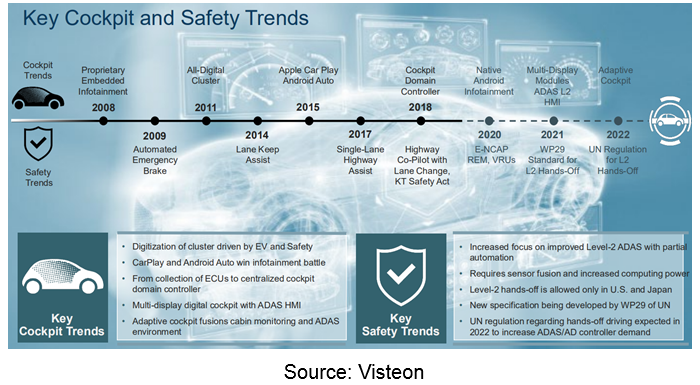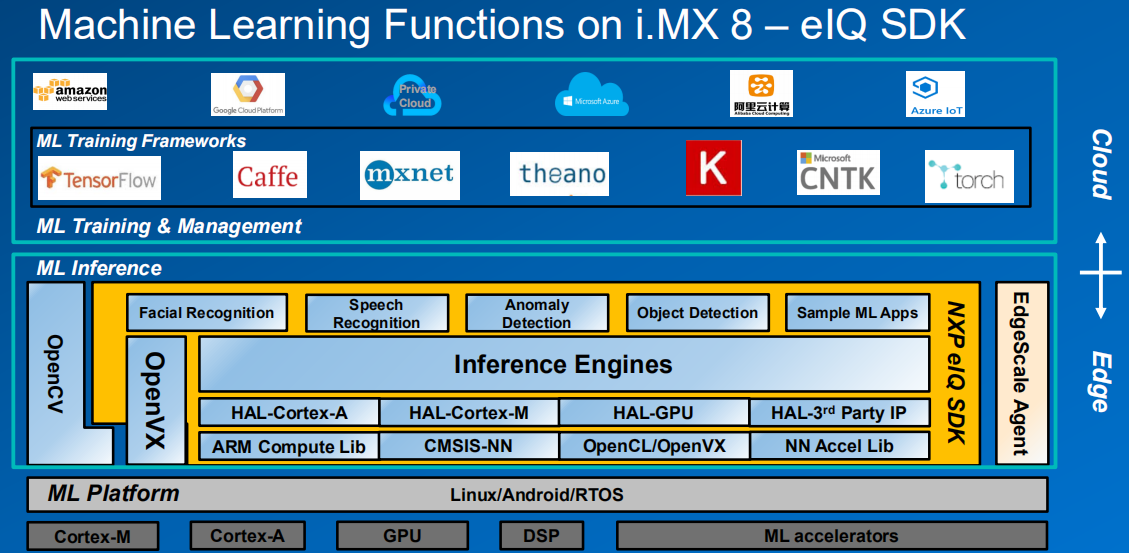Automotive Cockpit SoC Technology and Application Research Report, 2020
Cockpit SoC Supports More Displays, Beefs up AI, and Improves Functional Safety
Intelligent vehicle E/E architecture ushers in a period of intra-domain integration to trans-domain convergence and to central computer from the distributed one.

For cockpit domain, the intra-domain integration calls for powerful cockpit SoC which caters to the current cockpits’ needs to support more displays, enable more AI features and fuse with ADAS, have safer functionality, among others.
Support for More Displays
Against the trend of one core enabling multiple screens, it remains a decisive factor to being chosen by the user that how many displays a cockpit SoC can support. The third-generation Qualcomm Snapdragon cockpit SoC based on versatile CPU and GPU is an enabler for as many as six to eight displays.
Samsung Exynos Auto V9 processor is in favor of up to six in-vehicle screens and twelve cameras synchronously, which has been already found in Audi smart cockpits.
Designed for smart cockpit, SemiDrive X9 series unveiled by Nanjing Semidrive Technology Co., Ltd in 2020 support eight FHD displays and twelve cameras.
At CES2020, NXP showcased its multi-display solution supporting as many as 11 screens that are enabled by dual i.MX 8QuadMax.
Support for AI
Undoubtedly, NVIDIA stays ahead of its peers as concerns support for AI. NVIDIA rolled out CUDA in 2007 and had the idea of fostering an ecosystem via CUDA then, which is helpful to both hardware sales and its superiority in software as well as to user loyalty. Despite its cockpit SoC gets a clear edge in deep learning, NVIDIA enjoys not big a share in the cockpit processor market because of its automotive business focus on autonomous driving chips.
Through acquisition of Freescale, NXP is in possession of a machine learning expert team, i.e., CogniVue, an image recognition IP development team (acquired by Freescale in September 2015) based in Ottawa, Canada. NXP’s eIQ automated deep learning (DL) toolkit enables the developer to introduce DL algorithms to application programs, and meets the strict automotive standards.

Apart from its efforts in nurturing AI capabilities, NXP has been paying attention to AI defects. Deep learning employs probabilities to recognize objects and the results are inexplicable, which is disastrous to cars with a high demanding on safety. NXP has been studying a method called “explicable AI (xAI)” that extends the machine learning reasoning and probability computing capabilities through addition of more rational and humanlike decision-making methods and extra deterministic dimensions, and that combines all merits of AI with reasoning mechanism to imitate human reaction.
Fusion with ADAS for Higher Functional Safety
Some ADAS features like surround view parking, pedestrian and obstacle recognition tend to be integrated in the cockpit domain, needing the cockpit SoC to consider ADAS related capabilities.
R-Car H3, for example, gets largely utilized in cockpit and can also cope with complex functions such as obstacle detection, driver status recognition, danger prediction and avoidance.
More and more smart cockpits are added with HUD, especially the latest AR-HUD integrated with ADAS, delivering capabilities like following distance warning, line press warning, traffic lights monitoring, ahead-of-time lane change, pedestrian warning, road mark display, lane departure warning, obstacles ahead, and driver status monitoring.
There will be higher requirements on functional safety once cockpit SoC is added with some ADAS features, which will, beyond doubt, pose greater challenge to the cockpit SoC suppliers.
OEMs and Tier 1 Suppliers' Cost Reduction and Efficiency Enhancement Strategy Analysis Report, 2025
ResearchInChina released the "OEMs and Tier 1 Suppliers' Cost Reduction and Efficiency Enhancement Strategy Analysis Report, 2025", summarizing hundreds of cost reduction strategies to provide referen...
Automotive Fixed Panoramic Sunroof and Smart Roof Research Report, 2025
With the intelligent application of car roofs as the core, this report systematically sorts out a series of new products such as fixed panoramic sunroof/openable sunroof, ceiling screen, roof ambient ...
Automotive-Grade Power Semiconductor and Module (SiC, GaN) Industry Research Report, 2025
SiC/GaN Research: Sales volume of 800V+ architecture-based vehicles will increase more than 10 times, and hybrid carbon (SiC+IGBT) power modules are rapidly being deployed in vehicles.
Sales volume o...
Cockpit Agent Engineering Research Report, 2025
Cockpit Agent Engineering Research: Breakthrough from Digital AI to Physical AI
Cockpit Agent Engineering Research Report, 2025 starts with the status quo of cockpit agents, summarizes the technical ...
Prospective Study on L3 Intelligent Driving Technology of OEMs and Tier 1 Suppliers, 2025
L3 Research: The Window of Opportunity Has Arrived - Eight Trends in L3 Layout of OEMs and Tier 1 Suppliers
Through in-depth research on 15 OEMs (including 8 Chinese and 7 foreign OEMs) and 9 Tier 1 ...
China Commercial Vehicle IoV and Intelligent Cockpit Industry Research Report 2025
Commercial Vehicle IoV and Cockpit Research: The Third Wave of Passenger Car/Commercial Vehicle Technology Integration Arrives, and T-Box Integrates e-Call and 15.6-inch for Vehicles
I. The third wav...
Intelligent Vehicle Electronic and Electrical Architecture (EEA) and Technology Supply Chain Construction Strategy Research Report, 2025
E/E Architecture Research: 24 OEMs Deploy Innovative Products from Platform Architectures to Technical Selling Points
According to statistics from ResearchInChina, 802,000 passenger cars with domain...
Research Report on Intelligent Vehicle Cross-Domain Integration Strategies and Innovative Function Scenarios, 2025
Cross-Domain Integration Strategy Research: Automakers' Competition Extends to Cross-Domain Innovative Function Scenarios such as Cockpit-Driving, Powertrain, and Chassis
Cross-domain integration of ...
China Autonomous Driving Data Closed Loop Research Report, 2025
Data Closed-Loop Research: Synthetic Data Accounts for Over 50%, Full-process Automated Toolchain Gradually Implemented
Key Points:From 2023 to 2025, the proportion of synthetic data increased from 2...
Automotive Glass and Smart Glass Research Report, 2025
Automotive Glass Report: Dimmable Glass Offers Active Mode, Penetration Rate Expected to Reach 10% by 2030
ResearchInChina releases the Automotive Glass and Smart Glass Research Report, 2025. This r...
Passenger Car Brake-by-Wire (BBW) Research Report, 2025
Brake-by-Wire: EHB to Be Installed in 12 Million Vehicles in 2025
1. EHB Have Been Installed in over 10 Million Vehicles, A Figure to Hit 12 Million in 2025.
In 2024, the brake-by-wire, Electro-Hydr...
Autonomous Driving Domain Controller and Central Computing Unit (CCU) Industry Report, 2025
Research on Autonomous Driving Domain Controllers: Monthly Penetration Rate Exceeded 30% for the First Time, and 700T+ Ultrahigh-compute Domain Controller Products Are Rapidly Installed in Vehicles
L...
China Automotive Lighting and Ambient Lighting System Research Report, 2025
Automotive Lighting System Research: In 2025H1, Autonomous Driving System (ADS) Marker Lamps Saw an 11-Fold Year-on-Year Growth and the Installation Rate of Automotive LED Lighting Approached 90...
Ecological Domain and Automotive Hardware Expansion Research Report, 2025
ResearchInChina has released the Ecological Domain and Automotive Hardware Expansion Research Report, 2025, which delves into the application of various automotive extended hardware, supplier ecologic...
Automotive Seating Innovation Technology Trend Research Report, 2025
Automotive Seating Research: With Popularization of Comfort Functions, How to Properly "Stack Functions" for Seating?
This report studies the status quo of seating technologies and functions in aspe...
Research Report on Chinese Suppliers’ Overseas Layout of Intelligent Driving, 2025
Research on Overseas Layout of Intelligent Driving: There Are Multiple Challenges in Overseas Layout, and Light-Asset Cooperation with Foreign Suppliers Emerges as the Optimal Solution at Present
20...
High-Voltage Power Supply in New Energy Vehicle (BMS, BDU, Relay, Integrated Battery Box) Research Report, 2025
The high-voltage power supply system is a core component of new energy vehicles. The battery pack serves as the central energy source, with the capacity of power battery affecting the vehicle's range,...
Automotive Radio Frequency System-on-Chip (RF SoC) and Module Research Report, 2025
Automotive RF SoC Research: The Pace of Introducing "Nerve Endings" such as UWB, NTN Satellite Communication, NearLink, and WIFI into Intelligent Vehicles Quickens
RF SoC (Radio Frequency Syst...